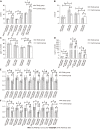Efficacy of enhanced extracorporeal counterpulsation combined with atorvastatin in the treatment of cognitive impairment after stroke
- PMID: 38186722
- PMCID: PMC10768497
- DOI: 10.5498/wjp.v13.i12.1027
Efficacy of enhanced extracorporeal counterpulsation combined with atorvastatin in the treatment of cognitive impairment after stroke
Abstract
Background: Cerebral apoplexy patients are prone to cognitive impairment, and it is very important to choose appropriate treatment methods to improve their cognitive impairment after stroke.
Aim: To evaluate the effects of enhanced external counterpulsation (EECP) in conjunction with atorvastatin on cognitive function, neurotransmitter levels, and the repair of brain tissue damage in patients with cognitive impairment due to stroke.
Methods: In this retrospective study, data from 60 patients with poststroke cognitive impairment due to stroke who were treated in our hospital from February 2021 to July 2022 were analyzed and divided into a treatment group (n = 30) and a control group (n = 30) according to the different nursing methods applied. Patients in the treatment group received EECP in addition to atorvastatin, while those in the control group received atorvastatin alone. Mini-Mental State Examination (MMSE), Montreal Cognitive Assessment (MoCA) and activities of daily living (ADL) scale scores were compared between the two groups. Additionally, the two groups were compared in terms of serum acetylcholine (ACh), acetylcholinesterase (AChE), nitric oxide (NO), endothelin-1 (ET-1), β2-microglobulin (β2-MG), glial fibrillary acidic protein (GFAP), and visinin-like protein 1 (VILIP-1) in the serum. Blood flow measurements from the anterior cerebral artery (ACA), middle cerebral artery (MCA) and posterior cerebral artery (PCA) were compared between the two groups before and after treatment, and the pulsatility index (PI) and resistance index (RI) of each artery were determined.
Results: MMSE, MoCA, and ADL scores all improved in both groups following treatment, with the study group showing more improvement than the control group (P < 0.05). After treatment, there were statistically significant increases in both ACh and NO levels, whereas decreases occurred in AChE, ET-1, β2-MG, VILIP-1, and GFAP, levels and the PI and RI of the left-ACA, right-ACA, left-MCA, right-MCA, left-PCA, and right-PCA. The study group showed greater gains in all metrics than the control group (P < 0.05).
Conclusion: EECP combined with atorvastatin is effective in the treatment of cognitive impairment after stroke and can effectively improve the cognitive function, neurotransmitter levels, and brain tissue damage status of patients.
Keywords: Atorvastatin; Brain tissue damage status; Cognitive impairment after stroke; Enhanced extracorporeal counterpulsation; Neurotransmitters.
©The Author(s) 2023. Published by Baishideng Publishing Group Inc. All rights reserved.
Conflict of interest statement
Conflict-of-interest statement: All the authors report no relevant conflicts of interest for this article.
Figures

Similar articles
-
Effects of Early Acupuncture Combined with Rehabilitation Training on Limb Function and Nerve Injury Rehabilitation in Elderly Patients with Stroke: Based on a Retrospective Cohort Study.Biomed Res Int. 2022 Apr 23;2022:8557936. doi: 10.1155/2022/8557936. eCollection 2022. Biomed Res Int. 2022. Retraction in: Biomed Res Int. 2023 Nov 29;2023:9873414. doi: 10.1155/2023/9873414. PMID: 35502338 Free PMC article. Retracted.
-
Acute Hemodynamic Responses to Enhanced External Counterpulsation in Patients With Coronary Artery Disease.Front Cardiovasc Med. 2021 Nov 12;8:721140. doi: 10.3389/fcvm.2021.721140. eCollection 2021. Front Cardiovasc Med. 2021. PMID: 34869627 Free PMC article.
-
Efficacy of Fuyuan Xingshen Decoction Combined with Butylphthalide Sodium Chloride Injection in the Treatment of Acute Cerebral Infarction and Its Effect on Hemodynamics.Evid Based Complement Alternat Med. 2022 Sep 19;2022:2402040. doi: 10.1155/2022/2402040. eCollection 2022. Evid Based Complement Alternat Med. 2022. Retraction in: Evid Based Complement Alternat Med. 2023 Dec 6;2023:9754181. doi: 10.1155/2023/9754181. PMID: 36193139 Free PMC article. Retracted.
-
Clinical efficacy of Danshen preparation in the treatment of vascular cognitive impairment: A systematic review and meta-analysis.Front Aging Neurosci. 2023 Jan 20;14:1090665. doi: 10.3389/fnagi.2022.1090665. eCollection 2022. Front Aging Neurosci. 2023. PMID: 36742208 Free PMC article. Review.
-
Effects of moxibustion on cognition and activities of daily living in post-stroke cognitive impairment: A systematic review and meta-analysis of randomized controlled trials.J Nurs Scholarsh. 2023 Mar;55(2):464-476. doi: 10.1111/jnu.12846. Epub 2022 Nov 8. J Nurs Scholarsh. 2023. PMID: 36345735
Cited by
-
Unveiling the Mysteries of Contrast-Induced Acute Kidney Injury: New Horizons in Pathogenesis and Prevention.Toxics. 2024 Aug 22;12(8):620. doi: 10.3390/toxics12080620. Toxics. 2024. PMID: 39195722 Free PMC article. Review.
-
Relationship between renal function and cognitive impairment in patients with stable schizophrenia: a multicenter cross-sectional study.BMC Psychiatry. 2025 May 15;25(1):494. doi: 10.1186/s12888-025-06952-8. BMC Psychiatry. 2025. PMID: 40375202 Free PMC article.
-
Enhanced Parkinson's gait, reduced fall risk, and improved cognitive function through multimodal rehabilitation combined with rivastigmine treatment.Am J Transl Res. 2024 Jun 15;16(6):2379-2388. doi: 10.62347/PAXI7650. eCollection 2024. Am J Transl Res. 2024. PMID: 39006262 Free PMC article.
References
-
- Rost NS, Brodtmann A, Pase MP, van Veluw SJ, Biffi A, Duering M, Hinman JD, Dichgans M. Post-Stroke Cognitive Impairment and Dementia. Circ Res. 2022;130:1252–1271. - PubMed
-
- Zhang X, Bi X. Post-Stroke Cognitive Impairment: A Review Focusing on Molecular Biomarkers. J Mol Neurosci. 2020;70:1244–1254. - PubMed
-
- Bai J, Wu D, Zhang J. A simulation study of external counterpulsation. Comput Biol Med. 1994;24:145–156. - PubMed
-
- Raza A, Steinberg K, Tartaglia J, Frishman WH, Gupta T. Enhanced External Counterpulsation Therapy: Past, Present, and Future. Cardiol Rev. 2017;25:59–67. - PubMed
LinkOut - more resources
Full Text Sources
Research Materials
Miscellaneous

